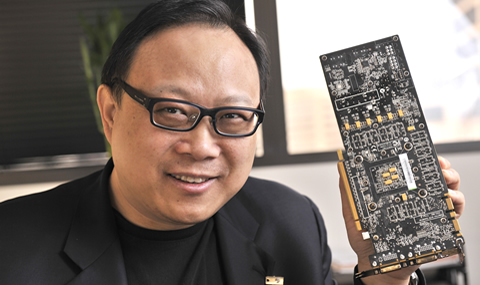Department of Radiation Oncology embraces technological innovation to improve patient care
The opening of the W.A. Monty & Tex Moncrief Radiation Oncology Building in 2003 helped usher in a forward-thinking emphasis on innovation by faculty members in the Department of Radiation Oncology.
UT Southwestern radiation oncologists, for example, have helped pioneer use of the latest technologies, such as stereotactic ablative radiotherapy (SABR), which offers the opportunity to treat formerly incurable cancers.
“Here at UT Southwestern, we have a unique opportunity to treat our patients with the most advanced technology combined with the most recent drugs. Treatments can be tailored or customized for their needs,” said Dr. Hak Choy, Chairman of Radiation Oncology. “We have the latest technology – some of it is the first of its kind in North America – to help facilitate extremely accurate treatment.”
Radiation Oncology currently is building a new three-story treatment facility that will consolidate clinical operations across campus into seven, and eventually 13, treatment bunkers. This will allow physicians, nurses, physicists, and researchers to be clustered in Disease-Oriented Teams, similar to those found in the Harold C. Simmons Comprehensive Cancer Center. Many of the leading-edge technologies that have gained the Department its progressive reputation will be a key component of the new Radiation Oncology home.
The team includes Dr. Robert Timmerman, Director of the Annette Simmons Stereotactic Treatment Center, Professor of Radiation Oncology and Neurological Surgery, and a world leader in stereotactic radiotherapy. Dr. Timmerman has helped lead a steady technological revolution in radiation oncology at UTSW that includes adoption of: the Gamma Knife for treatment of cranial tumors; one of the first robotic CyberKnife machines in the country; and Synergy S, a linear accelerator with image guidance that can deliver stereotactic treatments to the body based on a 4-D CT scan. That was followed by acquisition at UT Southwestern of North America’s first Vero, an SABR therapy machine that allows physicians to more precisely target radiation compared with some other technologies.
In another technological milestone, UTSW physicians were the first in Texas to implement Vision RT, a surface video monitoring system useful for image-guided radiation delivery for left-sided breast cancer patients, which spares patients from additional X-rays to the heart.
The technology buildup fueled other gains, such as a clinical trial for inoperable lung cancer patients that demonstrated control rates of 90 percent with SABR versus 30 percent using conventional therapies. UT Southwestern’s expertise also is being widely disseminated through continuing medical education courses for other medical professionals interested in practicing SABR.
The Department’s Molecular Radiation Biology Division, led by Dr. Michael Story, Chief of the Division and Professor of Radiation Oncology, has made landmark achievements including the development of a live animal model for testing SABR and its biological effects. Since 2005, the Division’s researchers have played a major role in obtaining over $17 million in NASA funding designating UT Southwestern as a Specialized Center of Research to study the health risks of space radiation for astronauts. Last summer, the Division’s researchers reported finding a molecule that inhibits KRAS, a gene that is mutated in about 30 percent of tumors. For decades, researchers worldwide have tried unsuccessfully to develop a drug to inhibit KRAS.

More recently, the Department recruited Dr. Steve Jiang, Vice Chair and Chief of Medical Physics and Engineering. Researchers in the Division are pioneering the adaption of graphic processing unit cards used in the video game industry to speed up time-consuming calculations used for imaging and planning radiation treatments. The goal is a treatment monitoring system that uses algorithms to account for day-to-day changes in a patient and the tumor’s anatomy. That will help deliver on the promise for personalized medicine tailored to each individual patient.
In addition, the National Cancer Institute recently awarded UT Southwestern a $1 million planning grant to develop proposals on behalf of a Texas consortium to establish the country’s first National Center for Heavy Ion Radiation Therapy Center for clinical care and research.
###
Dr. Choy holds The Nancy B. & Jake L. Hamon Distinguished Chair in Therapeutic Oncology Research.
Dr. Jiang holds the Barbara Crittenden Professorship in Cancer Research.
Dr. Story holds the David A. Pistenmaa, M.D., Ph.D. Distinguished Chair in Radiation Oncology.
Dr. Timmerman holds the Effie Marie Cain Distinguished Chair in Cancer Therapy Research.
